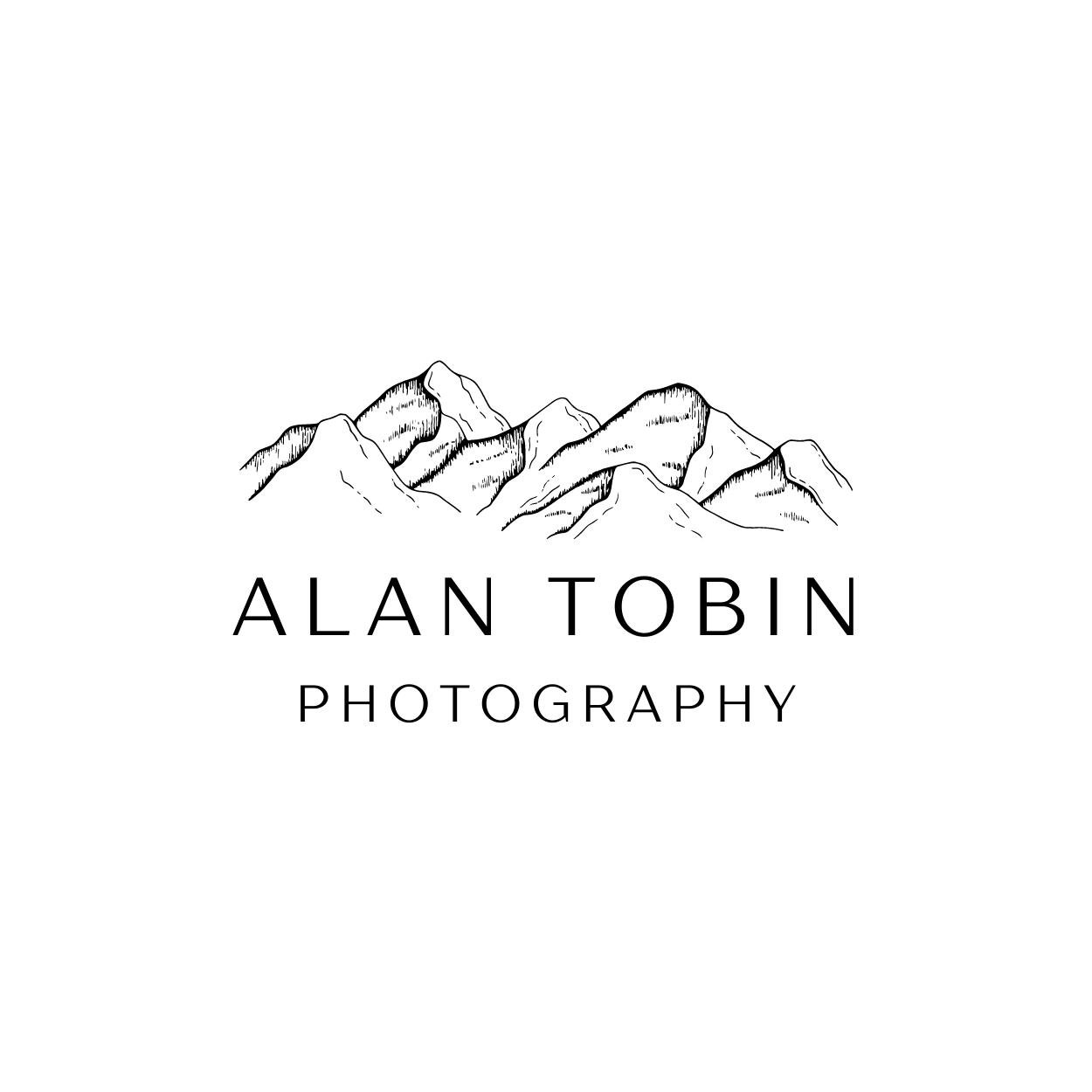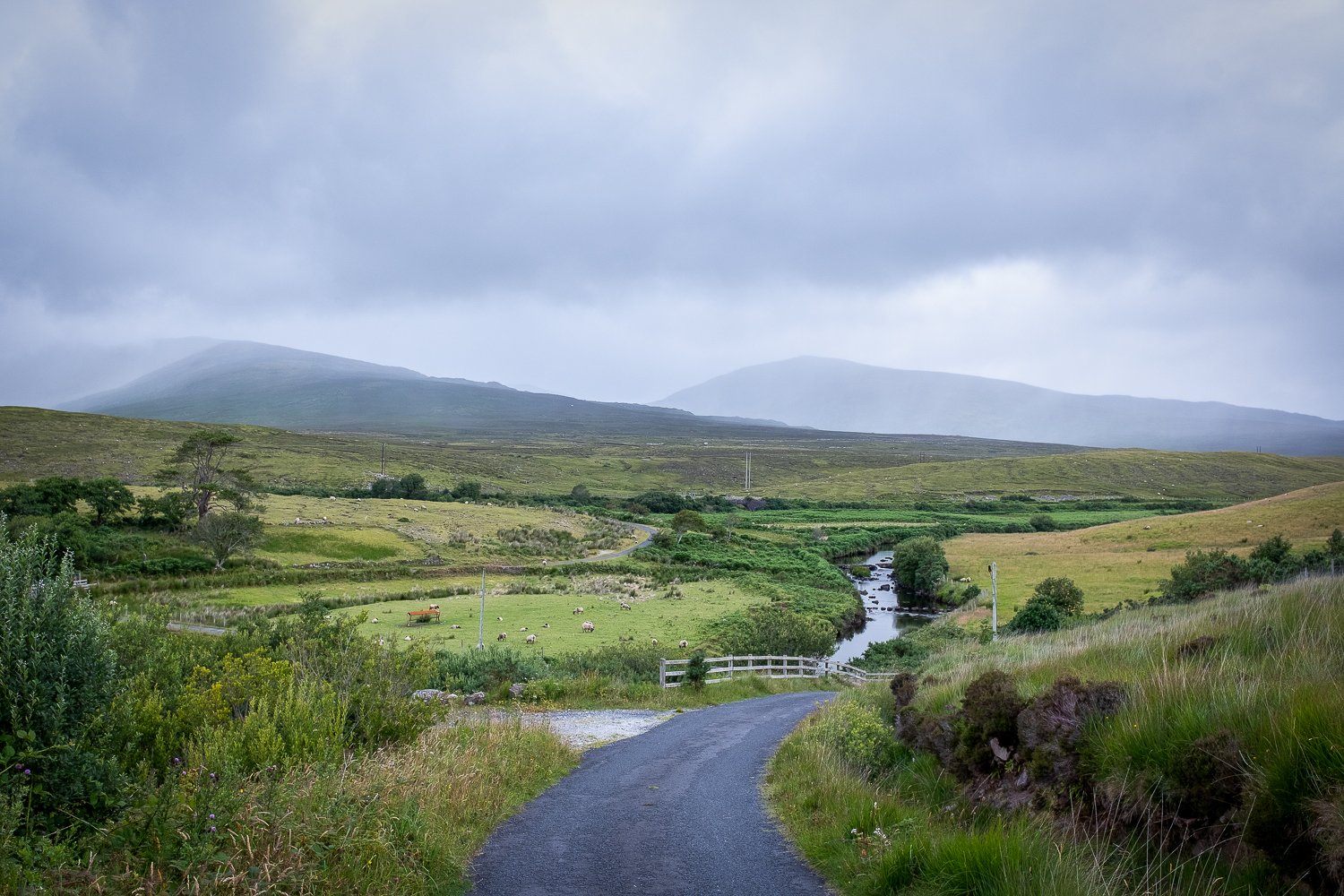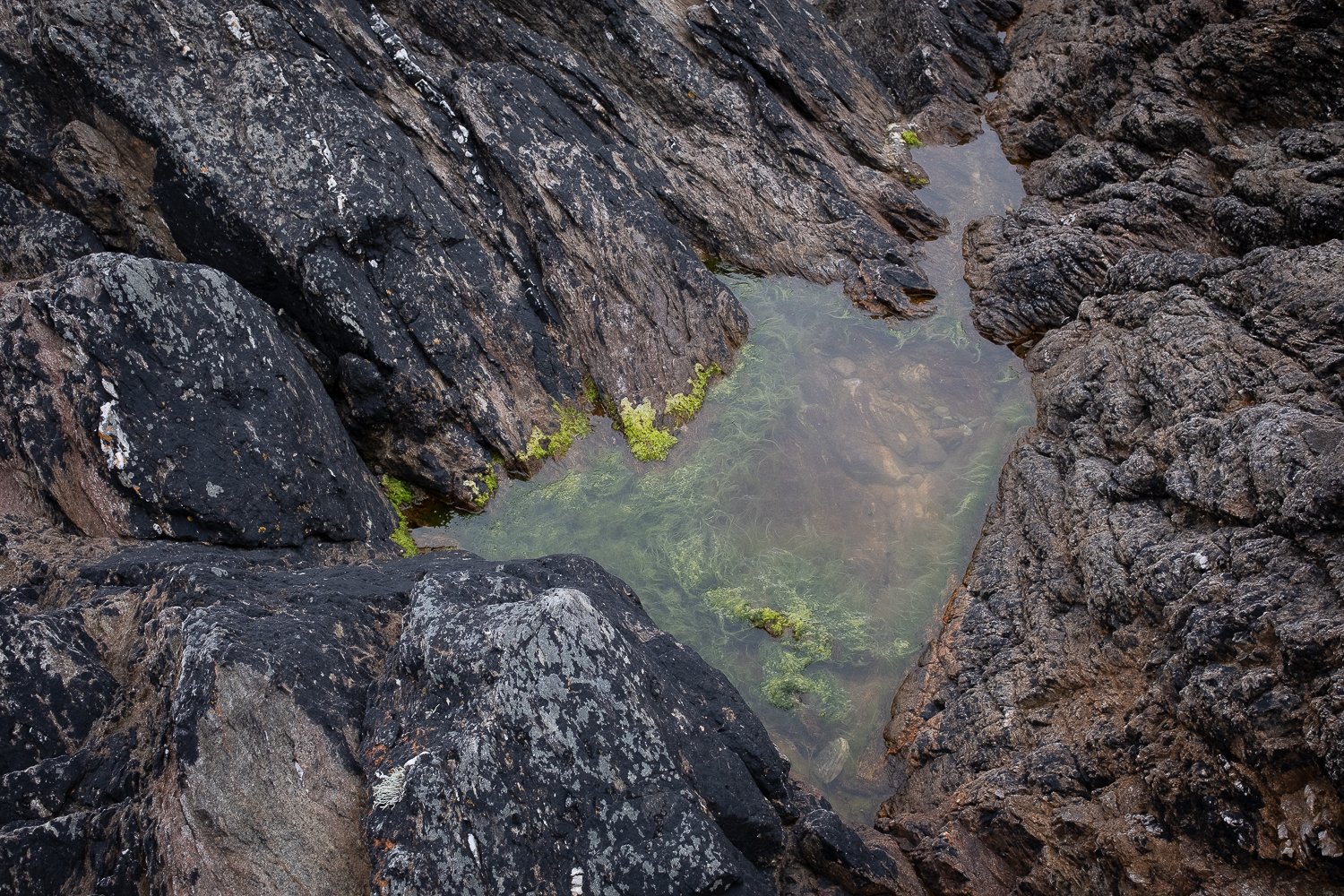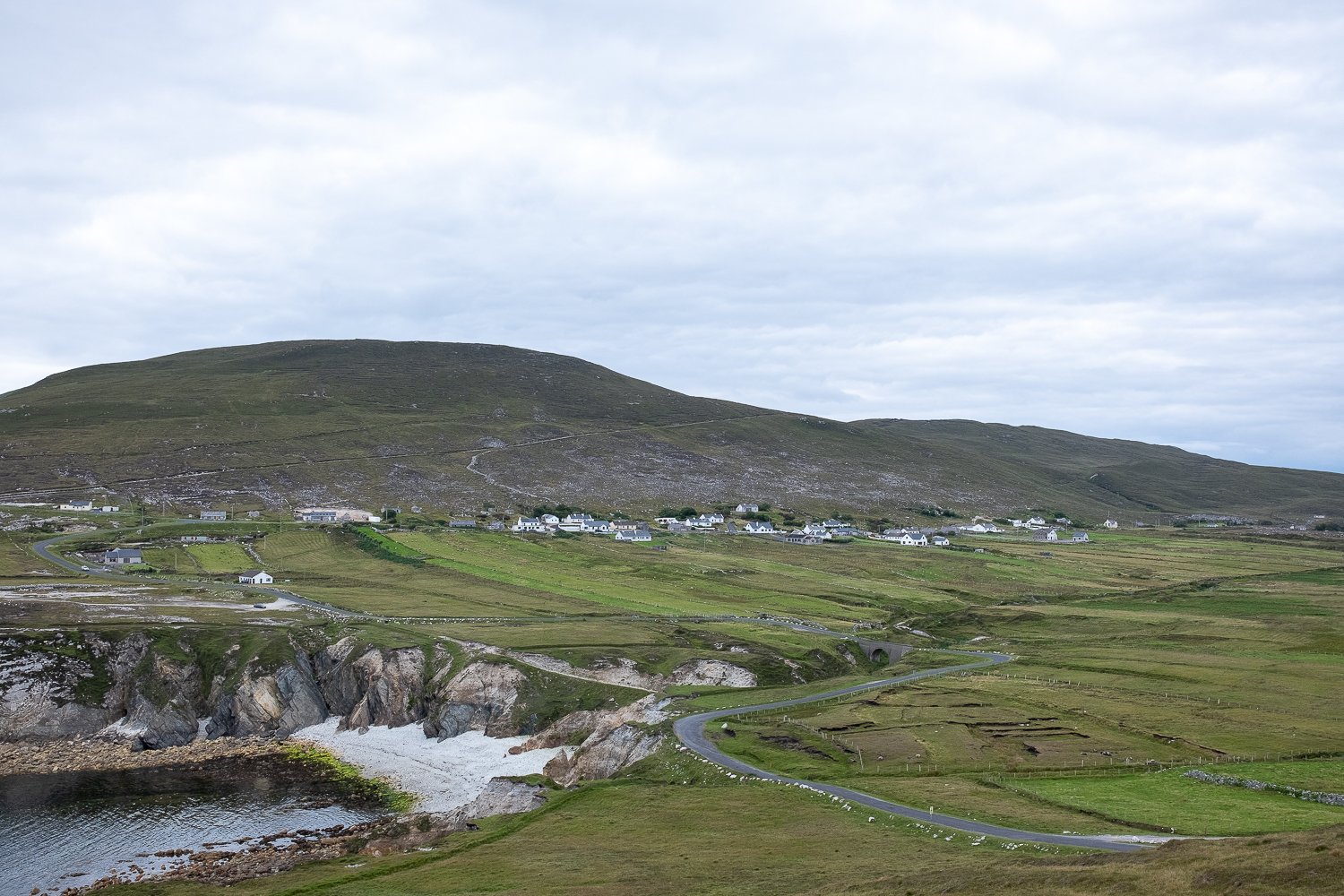Is Photography Mindfulness?
Is photography an exercise in mindfulness? Or are we too snap happy in the age of digital photography to be able to slow down? To approach this subject, let me start by telling you about a trip I took to Achill Island a couple of weeks back.
Here’s how I got there:
Monday
I drove from my home in South Tipperary to Westport, Co. Mayo. I parked the car in a long-term car park on the quay and stayed in a bed and breakfast for the night.
Tuesday
The following morning I had a bowl of crunchy nut cornflakes (continental breakfast, eh?) and the most beautiful cup of tea I’ve had in a long time. One of those that roasts you as it goes down your throat, not quite burning you but giving you that warming sensation that radiates throughout your body and is so comforting in the early morning. Nothing better.
I checked out and set off (on foot) with my backpack, my camera bag, my tripod and a flask of water.
Destination: the Great Western Greenway!
The Greenway is a 44km walking and cycling trail starting in Westport and finishing in Achill Sound. Much of it follows the old railway line which used to run out to Achill.
As it turns out, I was the only fool walking it. I spent two days doing so, staying in another B&B at the midway point. Each time a cyclist whizzed past me, I was reminded of just how slow walking is. Nevertheless I had set myself this goal as a personal challenge, with the added hope of getting some nice images along the way, and one good thing about walking or hiking as a photographer is that you get regular breaks - every time you see something worth photographing! Besides that I just kept reminding myself not to focus on how much path was still ahead. Just keep the rhythm of your steps and tip away at a steady pace.
The first leg of the journey, from Westport to Newport, runs mainly alongside the main road, and so wasn’t that interesting. The second leg took me as far as a place called Tiernaur, where I was booked in to stay the night. I was halfway there.
Wednesday
The following day, I had only wandered 10 minutes from where I had been staying the previous night when the first rain of my trip began to fall. A notable aspect of Greenways is that they are very exposed to the elements, whether that be intense sunshine or driving rain. There really isn’t much if any shelter. Luckily I still hadn’t rejoined the trail. I was on a path linking the main road (where my B&B had been) to the Greenway, and there was some sparse shelter available along this path.
I dipped in under a large rock which had a thick bush cushioned in and around it. A rock and a bough - one of you will provide me with shelter, I thought. As I sat crouched beneath the great stone, a sheep looked at me with no great curiosity. It, too, was wedged in against a stone to shield from the sideways rain. I stayed looking at the sheep, sharing a moment. When the rain had softened to a light mist, I emerged and stretched myself out. I looked back at the sheep one more time. I felt not so unlike her at that moment. Sometimes nature decides how we’ll go about our day.
This was my third stint of walking and at the end of it I reached Mulranny. It’s a beautiful spot with great views of the beach below. This morning trip was alarmingly short, only an hour and fifteen minutes, which was great except that it made me realise just how long the final part of my trip was going to be. I still had well over 3 hours of walking to do, and this was having already clocked about 30km since the previous morning. Coffee and a flapjack, and off again.
The last two hours of the trip were painful. Each step felt heavy and a kind of stiff, dull pain echoed lightly through my bones as I trudged on. The sort of aches you might get the morning after an inordinate amount of exercise, but I was feeling it there and then. I even felt like I had a strain on the inside of my right foot. An injury from walking? Can that even happen? Each time my mind wanted to despair about how far I still had to go, I would take a deep breath and put one foot in front of the other, focusing on keeping a steady cadence. I focused on the sound of my footsteps and the feeling of hitting the pavement. When my mind wandered, I reminded myself to bring it back. Left, right, left, right. Being on foot forces you to be patient and understand that you can not do things immediately. Especially over these long distances. You can speed up if you’d like, but you’ll suffer for it soon enough. Walking returns you to a place where you almost have no choice but to face the present moment, to enjoy and value that moment, because you know it’s going to be a while before you’re back home, or at the hotel, or wherever. Best to enjoy the process.
The upside on this final part of the Greenway was that it had saved its most scenic views for last. Much of the trail beyond Mulranny traversed bog (which I’m always fascinated by), and more of it hugged the coastline too, opening up into fantastic views of the mountains on the other side of the bay. My feet were glad of the breaks provided by my image-taking.
When I arrived in Achill Sound, the first order of business was to feed my face. Then a cup of tea. Then a fair amount of sitting and recovering. Before allowing myself to slip entirely into a food coma, I had to catch a late afternoon bus back to Westport. If I was going to make the most of Achill tomorrow, I would need my car to get around. And there was no way I was walking again….
As I stood at the bus stop with two other tourists, the bus having been due twenty minutes prior, I began to get that sinking feeling that perhaps the bus doesn’t run anymore, that I had read an outdated timetable, that the times were different now. All of these possibilities would have been more plausible had I not been able to buy my ticket directly from the Bus Eireann website, and had there not been two other people beside me also expecting the bus to arrive. Something else must have been amiss. I managed to find a customer service number on the Bus Eireann website and got through to a nice chap. After some confusion where I was calling it the “three twenty bus” (meaning the time - 15:20), whilst he searched for this mysterious “320” bus on his system. Eventually we realised we had our wires crossed and the actual bus number was 450. The good news was that the bus was indeed coming, but it had been delayed. It was going to arrive at 16:05. Quite the delay, which brought to mind the old Bus Eireann meme - “Timetables? Lol we just drive around.” More patience required. Standing on the side of the road. Time passing. You can’t make it go faster.
After a pleasant bus journey, I retrieved my car and drove straight back out to Achill.
Thursday (Achill Island)
I woke in a quaint room in an old farmhouse on the eastern side of Achill, where I was staying with an Irish-American couple and their friendly dog. It was an Airbnb, and Jane was a wonderful host. She welcomed me into her home without any show or pretence. She also has the gift of the gab and an appreciation for the tradition of storytelling on the island. I enjoyed her stories as I wolfed down the french toast and coffee she had generously served.
The previous night, I had made notes on the locations I could visit on the island and I would do my best to visit as many of them as possible today. As Jane said, I was going to “do Achill” in a day.
First thing in the morning, I headed north and parked at the Golden Strand. I walked along the beach at first, listening to the wash and fizz of water as the tide approached and receded. As I walked I kept my eyes peeled for any potential scenes worth photographing. My first instinct was to look for rocks aligned in a pleasing way that would guide the viewer’s eye towards the water. Each time I stumbled upon some interesting rocks, I would walk around to try and position myself for this kind of composition. After a few moments, I realised I should stop this endeavour. I should stop looking for this lead-in line, or trying to manufacture it, and perhaps I should even stop walking for a moment (heaven knows I’d done enough!). I stood still and looked with my eyes instead. This may sound silly but all photographers will know its importance.
Focus on what’s in front of you. What is in front of me? Well, seaweed mostly. It’s washing up on the sand. Some bits are drifting in and out with the tide. Some washes up further and settles there. Rather than orchestrating a scene with the rocks, I decided to focus more forensically on the sea’s debris. Not necessarily the bits left discarded on the sand, but the bits still in motion, the bits that the tide’s edge still reached. This helped to slow down my process. Setting up the tripod, moving ever so slightly to change perspective, finding the right aperture and shutter speed to go with. Each image now required careful planning, checking and rechecking my position as I looked at the real scene and through my viewfinder. I focused on the threshold - the line which the tide was just about reaching - because I wanted to allow the water to interfere with the subject while I was photographing it. Each time I found an interesting piece of seaweed, I would dig in the tripod’s legs, set up the composition in-camera, dial in the focus, get the exposure right, and then, finally lifting my head up from the machine, watch the water wafting in. I was using a 2 second timer to avoid any camera shake. So I did my best to time pressing the shutter about two seconds before the water would reach the seaweed within my frame. This took trial and error. I found an hour and a half had passed before I had even noticed, occasionally moving to a new subject and setting up the shot again with the same process.
From Golden Strand I moved westward, stopping off at Doogart beach, where the impressive Slievemore looms over the strand.
From there I drove to the nearby Deserted Village. This is a renowned tourist site on the island. A row of abandoned old stone cottages stretches for about a mile along the slopes of Slievemore. The practice of “booleying” saw families take residence in cottages like these for the summer months, to allow their cattle to graze, before returning to home base elsewhere on the island for the winter. This method continued to be practiced in Achill over a hundred years after it was abandoned in other parts of the country. If you’re interested in learning more about booleying, please see this article published by RTE:
https://www.rte.ie/brainstorm/2021/0422/1211486-booleying-ireland-summer-migration/
If you’d like to read more about this village specifically, try these:
http://www.visitachill.com/en/desertedvillage.html
I took some images there. None that I was particularly happy with. After fifteen or twenty minutes of shifting around looking for an angle to capture some of the ruined cottages, I began to realise that this was hindering my ability to soak in the history and the emotional significance of the place. Sometimes, using a camera better equips you to explore a subject. Other times, it impedes your ability to just engage directly with what’s in front of you. So I put the camera away and walked the mile road, allowing my mind to wander off to scenes of whole families traversing the countryside, cattle in tow, to a temporary new home and new pastures. This way of life clearly became unviable, but I like to think a certain amount of that toughness and defiance, that connection to and understanding of the land, might live on in the people of Achill today.
Back in my car, I navigated to Keem Strand. It’s one of the most well known spots on Achill and a favourite for beach-goers. I wasn’t as hugely interested in Keem. A busy beach isn’t really my thing, nor the commercialism that goes on around it, but I knew it would be unwise not to wander over for a look. I might miss a hidden gem. This proved to be correct as the cliff-edge drive as you descend towards Keem is worth the visit alone. I found two lay-by areas en route where I got some picturesque images of the bay below, and the narrow strip of beach at its centre. The beach itself was thronged, of course. Though the weather was mainly overcast that day, the sun had come out for the half hour during which I was in the vicinity of Keem, which allowed me to see this summery destination as it should be seen. As expected, not only was the car park full, but the winding road down to the strand was narrowed by parked cars all the way down. I turned around and headed back along the coast in the opposite direction. Nothing for me here.
My coastal drive took me through Dooagh and Keel, both also well known for their beaches, and then I veered away from the coast and cut inland through the heart of the island, heading back towards Achill Sound. It was time for lunch, and the place I had eaten there yesterday had left an impression.
Fed and happy, I set about exploring the only part of Achill I hadn’t touched yet. The southern strip. There were several spots I had bookmarked to stop off at during this coastal drive and so I set off, anticipating frequent pulling over and hoping for some breathtaking views. The southeastern coast was fairly nondescript until I neared the southern tip. Cloughmore is the name of the location where you round the tip and start to swing north. It’s a beautiful viewpoint, looking out over the vast ocean with walls of jagged rock and dark stony beaches beneath you.
Having taken a number of scenic shots of the ocean and the volcanic-looking rock flanking it on both sides, I took a similar decision to the one made on Golden Strand that morning. That is to move from macro to micro, from expanse to the tiny details, and to zoom in on a smaller scene. To spend time with one scene, engage with it, give it space and time to grow into its own narrative. I walked down across a stony beach with huge perfectly round pebbles, stumbled with each step across the near-boulders, until I reached the walls of spiky black rock which stretched all the way to the water. I scouted the hills and valleys of this miniature ancient landscape, searching for a detail that lured me. Finally, I found a pool of water in one of these miniature valleys.
My photography has started to switch gears in this way in the past year or so. I have begun to focus on more intimate, smaller scale scenes, rather than the expansive landscapes of before. The changeover is not wholesale yet, but the process has certainly started. I have begun to focus more on things like the surface of a rock, or the glassy sheen of a pool of rainwater. I have taken images of dark spaces beneath rocks, in animal dens, under bridges, or in any kind of hollow place. I have taken images of wild mushrooms, a sheep’s skull, a knot in the gnarled bark of a tree… All of this is to say that I have tried to move my photography to a place where it engages with the minutiae of life, because that’s where I believe I can be more present in my work. It’s through working in that way that I can engage with the present moment and value that moment more highly.
Is photography mindfulness, then? Well, perhaps the answer is that it depends. You absolutely can (and should) practice mindfulness in photography, and I think the medium is very well disposed towards that method. However, you could also use a camera to shoot a thousand pictures in a day and not really engage with the subject in any of those pictures. It really comes down to how you work. I definitely feel as though I have benefited hugely from working with film cameras in recent years. Though I have moved over to a digital camera now, I have brought with me a certain slowness and a measured approach to taking photographs. I’m not perfect. As you’ve seen already, I occasionally slip into working unconsciously, taking “snaps”. But it’s something I’m aware of and I will try to pull myself out of. In the same way that I’ll catch my mind wandering from the sounds of my footsteps to the despair of the road ahead, so too do I have to rescue my mind from slipping into unconscious photography, where I’ll happily snap away until I get something pretty on the eye, and return my focus to the subject at hand and how best to dialogue with it.
Back in my car, I continued along the coastline as far as the White Cliffs of Ashleam. Along with Cloughmore, this is another officially marked location on the Wild Atlantic Way. And it is a stunning location. The white cliffs are reminiscent of Dover in the UK. The white cottages in the distance, the chalky grey stone on the slopes of the mountain behind, and all around a carpet-like tapestry of graduating shades of green.
The first image I took of the cliffs from the standing position in the image above, was a more traditional one. I had the sea dominating about two-thirds of the frame. I positioned the cliffs on the right side of the frame, one-third of the way up and one-third of the way across from right to left. In other words, using the Rule of Thirds. Making the composition pleasing to the eye almost by default. However, I also took a second image. This image was less traditional, placing the cliffs in the centre, and including only a small corner of the sea on the far left.
It was only when I was looking through these images days later that I realised I was much more enamoured with the more unconventional version. The winding road on the right, and the cliffs on the left, meet in the middle - they rub up alongside one another for the briefest stint, before meandering away in opposite directions. It was this sense of push and pull that really grabbed me in this image. The road and the cliffs. The man-made road, which aligns itself briefly with the coastline, before ultimately directing its way obediently around it, and the cliffs, which provide the natural border to the road’s playful weaving. Humans have learned to live in unison with nature on this island. They have built in and around it, but always “around” where necessary. Nature is non-negotiable, but we still have to negotiate it.
I asked myself, what is the difference between these two images?
The difference is that one is more mindful of the subject than the other. In fact, only one of the images actually engages with the subject of the photograph at all. The subject of the photograph, in this case, is the living, breathing life of the island, its history, its myth, its harsh weather, its barrenness, its wildness, and how human beings have learned to live on it.
Thank you for reading.
Alan
Never miss a blog post! Subscribe to my mailing list and have it come straight to your inbox.








